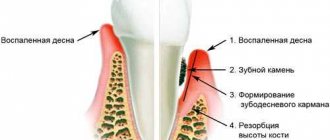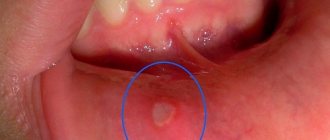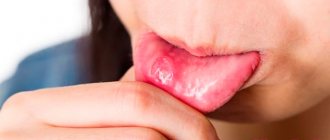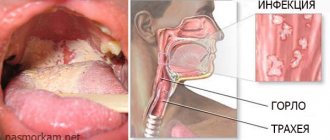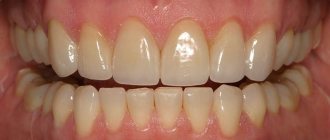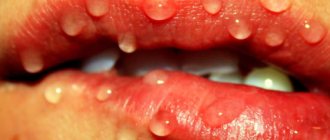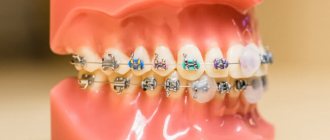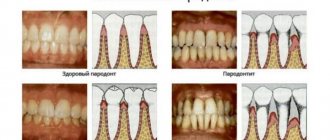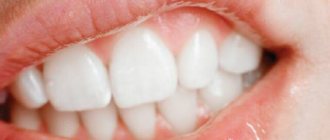A clear sign that an inflammatory process is developing is red gums. The condition can be accompanied by many unpleasant symptoms, both after eating or brushing teeth, and in the normal state.
Example of redness
After redness appears, you should immediately visit a dentist or periodontist, because the symptom may indicate the development of a serious disease. Lack of treatment can cause many complications.
Causes of redness
Red gums can be caused by one disease or several at once.
Most often this is inflammation, but other causes can be identified:
- weakened immune system;
- improper or completely absent oral care;
- lack of useful microelements in the body;
- abuse of bad habits;
- injury to the gums during brushing or eating;
- presence of tartar;
- disorders in the connective tissue of teeth.
Bad teeth are the source of many problems
Interesting! Redness of the gums around the tooth is more common in adults, but young children can also suffer.
As the disease develops, the gums begin to turn red and bleed. Most patients attribute the problem to damage during brushing, which is why they postpone a visit to the hospital until later.
After a while, swelling will appear and the structure of the gums will become loose. Without treatment, teeth will begin to loosen and fall out.
Black spots on the gums: causes, treatment, photos
If an adult has black spots on his gums, then this is a hematoma, which manifests itself both in children when they are teething and in adults during injury. Black gums also occur in heavy smokers. This disease is called melanosis and is associated with the accumulation of large amounts of melanin in the mucosal layer. The only option to forget about black gums forever is to quit smoking, and after time the gums will recover.
Read also: How to remove bad breath
Gums may darken due to periodontitis or gingivitis (in the form of lumps), or as a result of poor oral hygiene. Dark or black spots also appear due to systematic contact with heavy metals and harmful substances.
This phenomenon spoils a person’s appearance and may indicate disorders in the body. Having unhealthy gums, people begin to feel embarrassed about bad breath and have pain syndromes. As a result, a person begins to experience insomnia and the level of performance decreases.
Possible diseases
In dentistry, there are certain diseases that lead to redness of the gums above the tooth. They last a long time and are difficult to treat, as they require a number of therapeutic measures. The most common diseases will be discussed below.
Gingivitis
The condition is characterized by an inflammatory process of the gum mucosa. This is the most common disease among all others and can occur in both adults and children. At an early stage, a red spot appears on the gum, it is pinpoint, then the process spreads further.
The disease is dangerous and can cause many complications.
Depending on the severity of the disease, several types can be distinguished: catarrhal, atrophic, hypertrophic. Gingivitis can occur in a chronic or acute stage.
The disease develops more often against the background of insufficient oral hygiene, which is why plaque begins to form on the enamel. In addition, pathology can occur when dentures, fillings or crowns are installed incorrectly.
This causes injury, which leads to an inflammatory process. If treatment is started on time, gingivitis can be successfully treated. In advanced cases, teeth may fall out.
The video in this article explains in more detail how the disease develops and what its symptoms are.
Periodontitis
It ranks second in terms of frequency of development. During the development of the disease, the ligament between the bone and the tooth root is broken. The gums become deformed and a pocket appears where food will accumulate. It is almost impossible to get rid of it with your own hands.
Example of disease development
While chewing, discomfort appears, swelling and pain bother you. A strong inflammatory process develops with pus, which is easily released when pressed. In the acute form of development, fever and other symptoms of intoxication may be disturbing.
Interesting! At an early stage, traditional treatment is carried out - removal of dental plaque, filling, sanitation of the oral cavity. In advanced cases, surgery cannot be avoided.
Periodontal disease
The disease is not accompanied by inflammation. The gums are red because the blood supply to the tissues is impaired. Dystrophy appears, the cervical area is exposed, and large gaps appear between the teeth.
Unlike periodontitis, there is no clear location; both jaws are affected. The causes of periodontal disease are impaired metabolism, hormonal imbalance, and systemic diseases.
Treatment begins with a comprehensive diagnosis; first of all, it is important to identify the cause that caused such a problem.
In the photo below you can see what the symptoms of the disease are.
In advanced cases, the neck of the tooth is completely exposed
Redness after tooth extraction
What to do if the gums become red after tooth extraction? In general, minor redness and swelling is normal and should not be a concern.
You should worry if the symptoms persist for more than three days, and in addition to redness and swelling, the temperature rises, an unpleasant odor and bleeding appear. In this case, inflammation can be caused by improper anesthesia, injury to the gums, improperly performed surgery, etc.
Why do gums darken? Causes of the disease
darkened gums
Most often, black gums are observed in smokers. Spots localized on the soft tissues of the jaw can be pinpoint, extended, large or small in size.
Among the causes of blackening are the following:
- Smoking is the most common cause.
- Caries is often accompanied by a change in the color of the tissue around the tooth.
- Presence of tartar.
- Gingivitis and periodontitis.
- Stomatitis.
- Jaw injuries.
- Dental filling using amalgam. Moreover, the more teeth were filled in this way, the greater the number of stains.
- Addison's or Peutz-Jeghers disease.
Smoking and dark gums
A person who consumes nicotine exposes the entire body to harmful effects. Almost all smokers have the following symptoms to one degree or another:
- darkening of teeth;
- the appearance of black spots on the gums;
- bitter taste in the mouth;
- bad breath.
In the treatment of darkening, the method of laser therapy is usually used; small lesions can be cured with folk or pharmacy remedies.
You should know that stain removal should be started only after completely quitting smoking. If you return to a bad habit, the problem may arise again.
Stomatitis as a cause of gum blackening
When the lining of the mouth becomes inflamed, the condition is called stomatitis and is associated with the body's immune response to an irritant. Among the causes of stomatitis are:
- Stomach diseases (gastritis).
- Foci of inflammation of the walls of the small and large intestines.
- Infestations due to worms.
- Insufficient oral hygiene, resulting in inflammation.
Stomatitis is characterized by the presence of yellow or whitish ulcers and black gums. However, they can acquire a rich dark shade due to inflammation penetrating deep into the soft tissues or bleeding. Stomatitis is treated with local remedies without the use of hardware methods.
Black spots from amalgam fillings
Today, amalgam fillings are rarely used. Mercury and silver, which are part of such a filling, cause darkening of the gums around due to prolonged contact.
Discoloration from an amalgam filling is not harmful to health.
Smoker's melanosis
This term refers to a change in the shade of the oral mucosa caused by smoking.
Smoker's melanosis
Often, such melanomas have the appearance of a pigment spot, which is colored light or dark brown. Precursors to the appearance of melanomas are often darkening of tooth enamel and bad breath due to nicotine use.
Smoker's melanomas are localized in the mandibular area, on the palate, floor of the mouth and inner surface of the cheeks.
A person diagnosed with melanoma requires constant medical supervision, since the appearance of such spots may be followed by the formation of a tumor.
Peutz-Jeghers syndrome and Addison's disease
In these painful conditions, dark spots appear not only on the gums, but also on the roof of the mouth, lips and tongue. The course of diseases is accompanied by manifestations in the oral cavity from an early age.
Trauma to the jaws and gums
Unexpected darkening of the gums around the tooth may turn out to be a hematoma, which arose as a consequence of a physical impact, such as:
- a blow to the face or jaw;
- severe compression by orthopedic structures or hard food;
- knocked out tooth;
- complicated tooth extraction.
A bruise forms at the site of injury due to ruptured capillaries. The resulting bruise is black or purple in color, which turns brown and yellow as the hemoglobin decomposes.
Important! In case of serious injury, a hematoma can provoke inflammation and necrosis, so immediate treatment measures must be taken.
Why does the gum around the tooth turn black?
If the tissues around the tooth have turned black, this may be a consequence of the use of low-quality materials in dental treatment or prosthetics. In addition, tooth decay may be the cause of dark spots. Advanced caries affects the condition of the oral cavity: the gums darken above the tooth and swelling forms. Certain hormonal fluctuations can also cause blackheads to appear on your gums.
Black spots on a child's gums
In children under one and a half years old, a black spot on the soft tissues of the oral cavity may indicate an erupting tooth. In this case, the phenomenon is temporary. However, the appearance of a bright red or brownish swelling on a child’s gum is a reason to contact a specialist.
gums before tooth eruption
In a child, black spots may indicate the onset of a disease, which is often caused by insufficient oral care, excessive consumption of medications, and weakening of the body's protective functions.
Attention! Inflammation in the mouth requires immediate examination by a doctor.
Suspicious symptoms
Many symptoms may indicate the beginning of the development of the inflammatory process; they appear gradually. As inflammation progresses, the intensity of the symptoms increases.
The clinical picture may look like this:
- the gums are red and sore;
- bad breath;
- the appearance of bleeding.
Appearance of redness
Red spots on the gums immediately catch the eye. If you notice this condition, but there are no other symptoms, this is still a reason to go to the hospital.
In the second stage of inflammation, bleeding appears. You can notice the release of blood during mechanical impact or while brushing your teeth. The phenomenon is serious and indicates that the disease is severe and long-lasting. Even slight palpation can cause severe pain.
The next stage is the formation of swelling, the accumulation of pus in the gum pockets, which causes an unpleasant odor.
Darkening of the gums above and below the tooth
The appearance of dark spots with a purple tint on the gums may indicate periodontal disease . In this case, the mucous membrane may turn red, swell and hurt .
Note! If left untreated, teeth may become loose and an unpleasant odor may appear in the mouth.
Periodontal diseases
Affects the area around and under the tooth. They are caused by lack of oral care and a bacterial infection. Having passed into the chronic stage, the disease affects the mucous membrane, gum tissue, and bone that supports the teeth . One tooth or several at once may be damaged.
The most common periodontal diseases are gingivitis and periodontitis. At an early stage they affect only the teeth . Later, gum tissue and bone are included in the process. The tissues holding the tooth become loose, which leads to its loss . People of any age can get sick.
Symptoms of periodontal disease
- bleeding during dental hygiene;
- sensitive, loose, swollen gums;
- the appearance of abscesses, ulcers;
- gradual displacement of teeth relative to their original position;
- bad breath;
- incomprehensible discomfort, lack of healthy shine of gums and enamel.
Note! In the initial stage, most patients do not experience these symptoms.
Causes of the disease
The main reason is a bacterial infection , plaque infested with bacteria that is not removed regularly.
It is caused by plaque settling at the base of the tooth. The gums become red, swollen, and painful . This is an early stage of periodontal disease and is not difficult to cure.
Periodontitis
Progressive gingivitis. The gums are already beginning to lag behind the tooth , bacteria penetrate into the pocket that appears, and the infection rushes deep into the tissue. Bacterial toxins gradually begin to destroy bone tissue , and the mucous membrane darkens. The disease ranges from mild to moderate to severe when tooth loss is inevitable.
Treatment methods
If your gums are red and painful, you should seek help from the hospital as soon as possible. At home, you can only relieve unpleasant symptoms, but not eliminate the cause of their occurrence. Therapy is prescribed only after a comprehensive diagnosis. The most effective and common treatment methods will be discussed below.
Hygienic teeth cleaning
If the disease has caused a large amount of plaque and stone, this procedure is necessary. Recently, ultrasonic or laser cleaning has been used for this purpose. The advantages of mechanical cleaning are that there are no side effects.
After professional cleaning, teeth become white and gums become healthy.
Anti-inflammatory therapy
If the gum above the tooth is red, and the reason lies in the inflammatory process, dental products can be used, namely, ointments and gels.
The most effective are considered:
| Name | Description |
| The gel is used in dentistry and has several effects: analgesic, anti-inflammatory, antimicrobial. There are two forms: children's and adults. |
| The combined action agent is used in dentistry. The release form is liquid, the smell is reminiscent of menthol. It is used both as a preventive measure and for the treatment of oral diseases. |
| The drug accelerates regeneration processes, relieves inflammation and pain. In addition, the oral mucosa is cleansed of pus and pathological bacteria. |
| The drug relieves inflammation in the oral cavity. It is not a bad analogue of other means. |
In particularly advanced cases, Solcoseryl or Actovegin may be prescribed.
Physiotherapy
They can be either auxiliary methods of treatment or primary ones. In case of gum disease, manual or hardware massage, electrophoresis or darsonvalization are performed. The main advantage of such methods is that there are no contraindications and can be used even for children and pregnant women.
Curettage of periodontal pockets
The procedure is indicated if there is pus in the gum pockets. The patient is given local anesthesia, after which the deposits are scraped out. It is extremely rare to have to dissect the gums.
Splinting
If teeth are loose, the procedure is considered necessary. The teeth are secured with a removable or non-removable splint, this reduces the likelihood of complications. During chewing, the load is evenly distributed.
Example of the procedure
Implantation
The gums are red and painful, what should I do? If this is associated with periodontitis or complicated periodontal disease, implantation is required. After the procedure, it is possible to eliminate malocclusion, and the condition of bone tissue improves.
Interesting! Surgical methods are an emergency measure. After the intervention, the patient is observed by the dentist for a long time.
Can blood appear on the gums during teething?
Swelling of the gums can be local (around one or several teeth) and general - the tissues become swollen, red, and painful.
Moreover, the same symptoms of inflammation can have different causes. In addition, if the toothache has passed, but the gums are still inflamed, this does not mean that the problem has resolved itself: it is quite possible that inflammation of the soft tissues and an infectious process in the diseased tooth have begun.
As a rule, in very young children, swollen gums indicate teething. This is completely normal and should not cause any concern for parents. But if problems with gums began in a child 3-5 years old or older, swelling of the gums appeared, the lip increased in size, or all this happened after treatment or tooth extraction, measures must be taken.
The child's gums, cheek or lip near the tooth swell, he feels pain when chewing, there are noticeable changes in the contours of the face and there may be problems with speech and diction. The temperature may often rise. All these symptoms indicate that inflammatory processes are occurring in the gums and teeth and it is necessary to take measures to stop them as quickly as possible. It is necessary to carry out sanitation, use complex means to combat gum inflammation.
In dentistry, gum inflammation is called gingivitis. This disease can appear in a child not only during teething, but also after a visit to the dentist and treatment, as well as after tooth extraction.
If you are sure that gum swelling is not associated with the eruption of a baby tooth in a child, you need to take urgent measures to relieve him of unpleasant symptoms. Consult a specialist as soon as possible and take your child to see a dentist. The doctor will identify the most likely cause of the problem, if necessary, refer him to a periodontist, prescribe an x-ray and perform the necessary medical procedures to relieve the child of unpleasant symptoms.
If a child has swollen gums, the main task is to find the cause of the problem. Only eliminating the cause will minimize the risks and help maintain the health of the entire oral cavity.
It is important to understand that the treatment of gum inflammation depends on the cause of the pathology. The most common causes of swollen gums are:
- mechanical trauma to the gums, including as a result of medical manipulations;
- abscess in the gum due to caries;
- violations of oral hygiene with the development of pathogenic microflora in the mucous membrane and inflammation.
In addition to swollen gums, the child may also be bothered by painful sensations, which can greatly interfere with the quality of life of both himself and his parents. All kinds of painkillers and anti-inflammatory drugs from pharmacies will help relieve pain, as well as slightly reduce swelling during the prescribed treatment.
In addition, it is strictly forbidden to heat the inflamed area. This will not only not help you recover, but can also cause significant harm, accelerating the inflammatory process or, in the worst case, spreading it to neighboring areas of tissue. Even if the child’s pain goes away after warming up, this is not worth the problems that follow this method.
If your gums are inflamed and swollen, make sure that the problem is not related to teething. If a child’s gums are swollen after treatment or tooth extraction, or if the reasons are unclear, it is necessary to immediately see a specialist.
The doctor will help you find out why the problems started and choose the best solution for your child. Most often, during treatment you need to rinse the inflamed area generously, however, this should be done only after checking all the details with your doctor. In addition, with his permission, you can give your child painkillers so that the inflamed area bothers the baby less.
According to statistics, most problems with teeth and gums are associated with improper oral hygiene. Compliance with the rules of brushing teeth is an important condition for health, so from early childhood it is important to teach your child to take care of himself.
Experts' opinion
The active components of Asepta Teens toothpaste are:
- Olaflur (aminofluoride), which provides long-term protection against the effects of cariogenic bacteria and acids, saturates teeth with calcium and phosphorus.
- Xylitol, which enhances the remineralization of teeth and prevents the formation of caries
- Aloe extract, which moisturizes and stimulates the regeneration process of cells in the oral mucosa.
- Calendula extract, which has antimicrobial and anti-inflammatory effects.
Moreover, a study of the clinical effectiveness of the use of therapeutic and prophylactic agents of the ASEPTA series in the treatment of inflammatory periodontal diseases in children and adolescents was carried out by Ph.D. I.V. Klimova at the Department of Pediatric Dentistry of the Novosibirsk State Medical University allowed us to establish that:
- The Asepta line of products has a pronounced hygienic, anti-inflammatory, and hemostatic effect for periodontal diseases in children and adolescents.
- With the combined use of the products, an improvement in clinical indicators is observed, which confirms the high effectiveness in the treatment of periodontal pathology in children of different ages.
- The proposed treatment regimen using the Asepta treatment and prophylactic series of products can be recommended by a pediatric dentist in the complex treatment of inflammatory diseases of periodontal tissue in children and adolescents.
The rudiments of future teeth are formed during intrauterine development at approximately 7 weeks of pregnancy. The time of their eruption is completely individual. Some babies start teething at 5 months, while others start teething at almost a year. The lower incisors are the first to erupt, this occurs at approximately 6-9 months. After which the upper incisors erupt almost immediately (7-9 months). The full “set” is assembled at 2-2.5 years.
In the photo you can clearly see the condition and general appearance of the gums during teething. They differ from healthy and normal mucous membranes, which have a pale pink tint.
What gums look like in children:
- the mucous membrane becomes red and swollen;
- When the gums erupt, they change their structure (become loose);
- as the crown is pushed out, a white spot appears on the surface of the gum;
- When a sharp crown comes out on the surface of the gum, a small wound or abrasion occurs.
The signs listed above can be seen in the photo; they are a variant of the norm and are found in all infants. Sometimes a characteristic white or yellow coating appears (a large amount of saliva contains many bacteria), small hemorrhages in the form of red dots (if blood vessels are affected).
Swelling of the gums is a natural and easily explained process. Initially, tooth germs are located deep in the alveolar processes. Gradually they grow, enlarge and begin to be pushed out, which is called eruption. The crown first breaks through dense bone tissue. This difficult stage is not accompanied by pronounced symptoms or visual manifestations.
Swelling, redness and swelling appear when the crown passes through the upper soft tissue of the gum (the presence of the tooth becomes noticeable). Hyperemia is explained by tissue damage. When teeth are cut, their sharp edges actually cut soft tissue. As you know, any such damage results in swelling or inflammation.
When teething, the gingival mucosa is damaged and aseptic (i.e., “germ-free”) inflammation occurs, which causes fever, diarrhea, sleep disturbances and the baby’s appetite. At the same time, as a result of damage, the gums become more vulnerable to infection and the occurrence of septic (i.e., “microbial”) inflammation, which can complicate the already difficult period of teething.
Conventional drugs for the treatment of inflammation of the oral mucosa are not always convenient for use in young children. You should choose a drug intended for use in children. For example, Cholisal® has proven itself well. When applied topically, it has a triple effect, helping to relieve pain and inflammation and also acting on viruses, fungi and bacteria.
Often, teething is accompanied by unpleasant complications that alarm and frighten parents. These include hematomas, excessive hemorrhages or bruises, and sometimes bleeding.
We invite you to familiarize yourself with the clasp denture for the upper and lower jaw, prices and reviews
Blood on the gums appears very rarely. This happens when a capillary ruptures at the moment when the crown has just cut through the surface of the mucosa. Bleeding is usually preceded by prolonged and severe swelling of the gums. The gums bleed for a few seconds, then everything goes away. An isolated incident is not a serious cause for concern. If blood appears systematically, you need to consult a specialist.
The second complication is a hematoma in the gum hood. It appears when blood vessels rupture before complete eruption. The color of the hematoma is usually blue or purple. This indicates an accumulation of blood and other fluid inside.
In the photo above you can see what a hematoma looks like. Often it goes away on its own when the incisor comes out completely. If swelling is severe, medical attention may be required. Doctors cut the gum, ensuring the outflow of exudate. Doing this at home is strictly prohibited.
Traditional methods of treatment
In folk medicine, there are enough methods to eliminate redness on the gums, swelling and other unpleasant symptoms. The most effective way is rinsing.
Below are the most common recipes:
| Name | Mode of application |
| Lemon is the main ingredient in traditional medicine recipes. To relieve the inflammatory process, you can mix lemon juice and water, and then treat problem areas with the resulting liquid. Do not allow the product to come into contact with tooth enamel. |
| To prepare the solution, take part water and ten parts alcohol tincture and rinse your mouth twice a day. |
| Soak a cotton swab with oil and treat the gums. Rinse your mouth with water after ten minutes. To achieve results, it is recommended to carry out the procedure every day before bed. |
| The juice of the plant has an anti-inflammatory effect and is often used in folk medicine. Clean the leaf from the film and wipe it on the sore spot of the gum. |
| To relieve the inflammatory process, you can use lemon balm tincture. Pour half a liter of boiling water over a spoonful of herbs and let it brew for three hours. Strain the cooled product and rinse your mouth several times a day. |
| Grind several lemon peels in a blender, mix the resulting pulp with a small amount of vegetable oil. Let it brew for two days and apply the resulting ointment to problem gums several times a day. |
If you are experiencing severe pain, but there is no way to visit a doctor, you can take a pain reliever.
Principles of treating gum disease
The treatment regimen is developed by the doctor depending on the type of pathology that is accompanied by redness of the gums. Each dental disease requires an individual approach.
Gingivitis
The problem is characterized by inflammation of the periodontal papillae and the appearance of small pimples in this area. Treatment of the problem begins with the removal of hard and soft deposits from the surface of the enamel. After this, local anti-inflammatory and decongestant drugs are prescribed. The prognosis for recovery from gingivitis is usually favorable.
Periodontitis
The disease is considered a more serious form of gum tissue damage. If left untreated, the periodontal papillae atrophy, and balls filled with pus form in the periodontal pockets. Treatment of the disease is carried out in stages: taking or injecting antibiotics into the gums; splinting of moving elements of a row; surgical formation of atrophied areas of the gums.
Inflammation of the gums requires immediate treatment, since if the pathological process is complicated, periodontal disease or complete loss of the dentition may develop. There are many ways to combat the problem at home. Therapy includes the use of pharmacological drugs and traditional medicine. Mild forms of inflammation can easily be eliminated in a few weeks if all the rules outlined by the dentist are followed.
Oral care rules
How to get rid of red gums can be seen a little higher, but in order not to encounter such unpleasant symptoms, you should carefully monitor your oral hygiene. Hygiene should be instilled from childhood.
The following activities will also help maintain dental health:
- Use floss and toothbrushes. Thus, you can get rid of food debris even in the most difficult to reach places.
- Choose your toothbrush carefully. Take into account individual characteristics, the stiffness of the bristles may be different, choose exactly what suits you.
- Use rinse aids. After each meal, it is recommended to rinse your mouth with special products or plain water.
- When cleaning your mouth, pay attention not only to your teeth, but also to your tongue. A large number of pathogenic microorganisms accumulate in this place.
- If bleeding occurs, use an antiseptic mouth rinse.
- Avoid the development of infectious diseases.
Pregnant women or those who work in hazardous industries should pay special attention to the oral cavity. It is the teeth that first respond to all changes that occur in the body.
If any suspicious symptom is detected, it is not recommended to postpone your visit to the hospital. Remember that the oral cavity is the best place for bacteria, and they, in turn, can cause many unwanted complications.
Treatment
After an accurate diagnosis has been established, treatment of pigment spots in the oral cavity can occur using pharmaceutical drugs, dental procedures and traditional healing methods. But at the same time, it is necessary to follow the rules of hygienic care, performing the procedure of cleaning the dentition twice a day. After eating, use dental floss or mouthwash.
Medications
To eliminate the inflammation process, use:
Rotokan. Medicine based on natural ingredients. Therapeutic effectiveness is achieved by application after each meal (at least three times a day).
Metrogil Denta. Antibiotic based gel. If necessary, the course of therapy can be 30 days.
Chlorhexidine. Before use, the solution is diluted with water.
Dental procedures
The procedure using a laser is particularly effective. The antiseptic effect removes the symptoms of the inflammation process.
In addition, professional cleaning is performed in a dental office, removing surface plaque and plaque that forms in the dental pocket. The procedure using ultrasound has become very popular.
Traditional medicine recipe
As an additional therapy, in consultation with the doctor, the use of the following medicinal compositions is permitted:
- a collection based on mint, lemon balm, sage and oregano (prepared as a regular decoction);
- application with the application of a fresh aloe leaf (applied twice a day);
- baking soda solution for rinsing (1 spoon added to a glass of water);
- It is recommended to drink green tea throughout the day, as it removes toxic substances from the body (antioxidant effect).
It is important to know!
If the components of medicinal herbs are an allergen for the patient, then their use is strictly contraindicated. This can cause dangerous allergic reactions, including angioedema or anaphylactic shock.
Changes in the color of the gums, the appearance of pigment spots and dots should not be ignored, for which a person should contact a medical institution. It is very important to undergo a full examination, which includes a histology analysis.
Carrying it out will provide confidence that the resulting pigmentation is not caused by structural changes in cells, that is, they are not cancerous.
